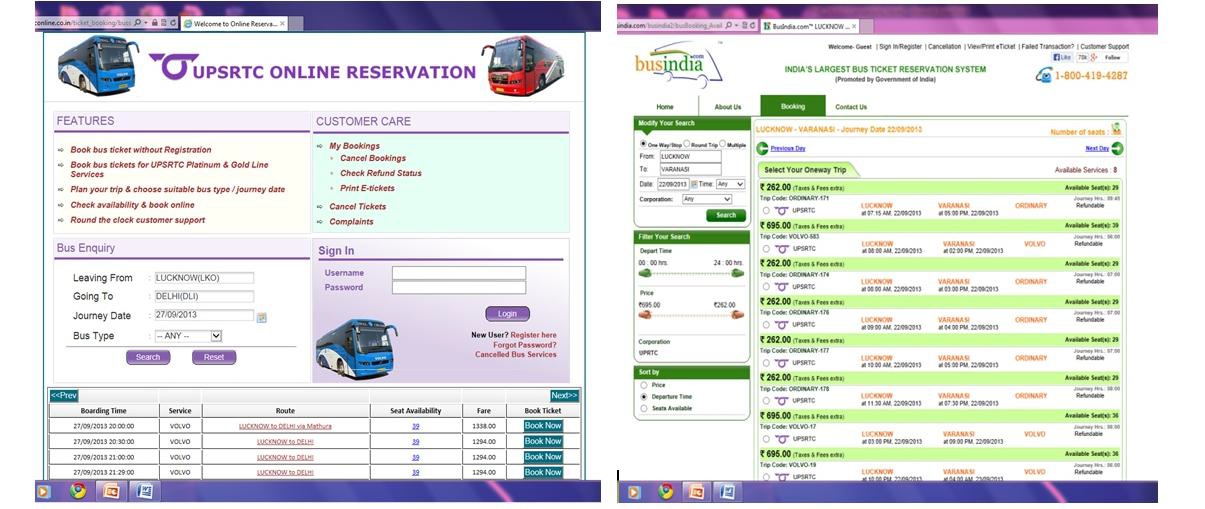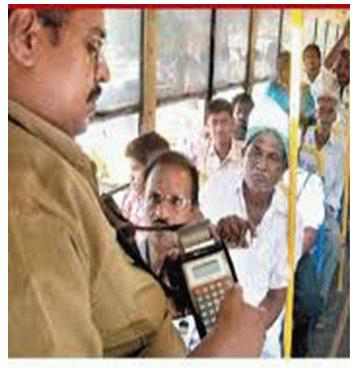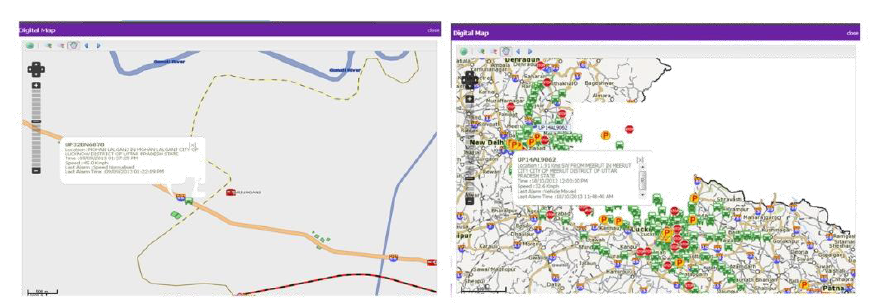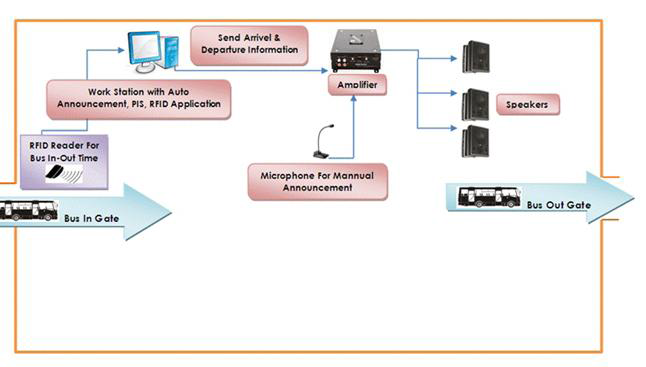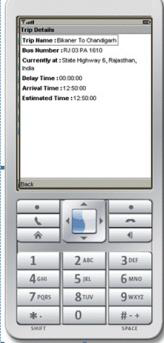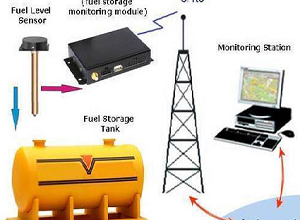An overview of UPSRTC intelligent transport management system (ITMS)
Modern transport telematics systems offer opportunities to make urban transport faster, more efficient and to support travelers. India has a long-term vision to achieve sustainable urban, sub-urban, inter-city and inter-state services and seamless movement of the commuters through technology intervention. Telematics in form of Vehicle Tracking and Passenger Information System(PIS) is the first choice for State Transport Corporations(STCs) in India. Recently, we published en exclusive CASE STUDY depicting the implementation of these technologies in Andhra Pradesh State Road Transport Corporation (APSRTC) buses. Today we bring to you a yet another of its kind…This time it is from the most populous state of India.
BACKGROUND
Uttar Pradesh State Road Transport Corporation provides passenger road transport services to the people of the state to various destinations within the state and adjoining state. It has a fleet size of over 9500 buses plying over 32 lakh kilometers per day and carrying over 15 lakh passengers. The Corporation annually provides travel services to over 55 crore passengers and has a turnover of over Rs. 3000 crores to enable it to meet its expenses from internal resources. With a view to strengthening its service levels and improving its service delivery the corporation embarked on a scheme for Intelligent Transport Management System (ITMS) in 2012-13. The scheme was sanctioned by the GoI which agreed to provide 50% of the capital investment of Rs. 38.25 crores as grants under ACA.
CONCEPT
The scheme of Intelligent Transportation Management System (ITMS) is passenger centric and has projected positive impact on the performance and profitability of UPSRTC by way of improvement in processes. UPSRTC is the pioneer state transport corporation which is undertaking a comprehensive project to this end. However, the project aims to revolutionise various operations and monitoring aspects and the impact would therefore become visible in passage of time. It also needs to be accepted and adopted by various stakeholders – passengers, staff, middle management and top management at policy level.
COMPONENTS:
UPSRTC has initiated the implementation of the Intelligent Transport Management System (ITMS) Project for the benefit of the passengers. The project includes IT enablement of its Ticketing & Passenger Information Systems. Online reservation through websites, counter reservation & current tickets, on board sales by conductors through ETMs, MST & pass sales, revenue reconciliation and accounting, Passenger information system at bus stations through display boards, automatic announcement systems, IVRS & SMS enquiry are components of the project. In the passenger information system UPSRTC is getting the LED displays and automatic announcement systems installed at bus stations. The system shall display information of departures from the bus station in next 1 hour, expected time of arrival & departure of services, general information for passengers, tourist information of the state and news feed. VT & PIS will cover core systems such as Vehicle Tracking System, Real Time Passenger Information System and Central Control Centers. Core technologies include GPRS, GSM, Geographical Positioning System (GPS), Display units and Information & Communication Technologies.
The ITMS project broadly involves following components:-
- Electronic ticketing – web based online tickets and advance reservations, mobile based ticketing, current counter tickets, use of hand held point of sales machines (ETMs) for on board tickets, introduction of Smart Card Travel Cards & Passes.
- GPS based vehicle tracking – real time tracking of all moving buses for operations control, arrival departure information and disaster management.
- Passenger information systems – web based real time expected time of arrival / departures, journey planner, LCD displays at bus stations, automatic announcement systems, pull SMS based enquiry and IVRS.
OBJECTIVES AND GOALS
The objectives and goals of the project from a public perspective are:
Ticketing convenience – online tickets can be booked from Corporation website and other leading ticketing portals such as makemytrip, redbus, travelyaari, hermes-it and busindia. Tickets can also be booked by downloading the Apps on mobile phones. The Coporation has set up 150 counters at its bus stations across the state and tickets for current departures can be bought from the counters. This also guarantees a seat in the bus. For on board tickets ETMs are used. Passengers get clear printed ticket with travel and price details and the digistised data goes to the Corporation servers in real time via GPRS.
- Payment convenience – Passengers using the online ticketing options can make payments by credit / debit cards, net banking or Interbank Mobile Payment System. Cash payment is accepted on counters or on board.
- Green Initiative – Passengers can use tickets in electronic format (on mobile phones or laptops) alongwith photo id with no need for a print out
- Disaster management & 24 x 7 helpline – The SOS button the GPS installed in the bus send SOS message to the control room and regional officers who provide assistance in disaster / distress – accident / breakdown / holdup as per standard operating practices.
- Travel information – The information of public interest, i.e. timetables, actual arrival departures, delays, seat availability, booking assistance and various schemes are made available through Website, IVRS, SMS, LCD Display Boards, Automatic Announcements.
The objectives and goals of the project from the Corporation’s perspective are:
- Revenue – The project enables auto digitisation of revenue data and easy reconciliation. It also has a potential for incremental revenue from advertisements on tickets and LCD displays at bus stations.
- Reduction in manual work, staff cost on ticketing & accounting, revenue & fuel pilferage and enforcement requirements
- Operations Control – Ensuring regularity & punctuality of services through effective monitoring, control on unauthorised halts of buses at wayside dhabas, checking over speeding, unscheduled operations, fuel consumption & cost control
PROJECT COST AND FUNDING
The project contemplates the setting up of a data center (with 23 servers and associated infrastructure), a disaster recovery center (with 18 servers and associated infrastructure), field level infrastructure – computers, printers, UPS, ETMs for each bus and reserve, VTS for each bus and reserve, SIM cards, LCDs at bus stations, automatic announcement systems and applications software. Owing to its scale and comprehensiveness the capital cost of the project is Rs. 38.25 crores of which 50% (Rs. 19.125 crores) is being funded as a grant under ACA from Government of India (GoI). UPSRTC, therefore, adopted a DBFOT methodology for selecting an investor who is a leading Systems Integrator through an All India Bid Mechanism. The selected SI is to invest the balance 50% capital expenditure and also the operations & maintenance expenditure on a 5 year contract. UPSRTC shall pay to the SI the grant component from GoI as upfront payment and the balance at a bid price of 44 paise per ticket over the next 5 years after successful implementation. The SI shall be monitored against a stringent Service Level Agreement (SLA) and shall be subject to graded penalty system. UPSRTC has factored this revenue in a surcharge named IT Cess collected from the passenger over and above the fare box revenue. The project thus has no investment or operations implications on the UPSRTC profitability, however, its incremental revenue potential shall contribute to the profitability in due course of time. The model of project funding and implementation has been found innovative by the GoI and is also being considered by other leading state transport undertakings on similar lines.
CURRENT STATUS
As per the guidelines of the ministry the SI (M/s Trimax IT Infrastructure, Mumbai) has been selected through an All India Open Bidding System. An agreement has been entered into between UPSRTC & SI on 10.4.2013 and the work has commenced and timelines for implementation are being met.
- Online Reservation System (ORS)
- Implemented with a payment gateway to ensure that ticket revenue goes to UPSRTC bank account directly.
- Available for popular Volvo & High End services, Goldline & prestigious ordinary services.
- Sub contracts for ticketing by leading 3rd party website – makemytrip, redbus, hermes,travelyaari & busindia.
2. Counter Ticketing
- 194 counters for current booking and MST counters have been set up in all the Regions – all infrastructure, software and manpower provided by SI. Daily cash receipts are deposited at UPSRTC depots and cash receipt (Form 44) authenticated.
- Electronic Ticketing Machines (ETMs)
- 11153 new GPRS ETMs supplied and implemented in all Regions.
4. Vehicle Tracking System
- GPS has been installed on more than 8000 buses of the 20 regions of UPSRTC of which close to 7500 are reporting on servers. Application software developed and commissioned. The information forms a feed for Passenger information system & Control rooms.
5. Central and Regional Control Centers:
- Control room design & MPLS connectivity done at 17 places which includes Head Office and is in progress at 4 locations.
6. Passenger Information System (‘PIS’)
- 245 LCD screens (40″) and automated passenger announcement system set up at various Bus stations in UP.
7. Data Center and Disaster Recovery Center
- Data Center set up at Mumbai & Disaster Recovery center at Bangalore with requisite infrastructure and is functional.
- Mobile ticketing apps developed & tested – to be launched soon.
- 24×7 call center service for help / grievance redressal of users of ticketing setup at HQ (18001802877).
- 89 counters being set up for Smart Card issue in all Regions – Agreement with ICICI Bank & card design approved – to be launched soon.
- Passenger information software for website, IVRS and pull SMS being designed, tested for implementation.
- Smart Card based service wise automatic arrival / departure recording system to be implemented – application tested and card design approved. It was launched by the honorable transport minister Shri Durga Prasad Yadav. So far there has been a total registration of 238 cards.
CONCLUSION:
With the introduction of Intelligent Transport System Project, UPSRTC is now able to manage the entire fleet operations more efficiently through on-line remote access to vehicle positions, speed, breakdown, accident/ incident, etc and make appropriate decisions using the MIS reports that support all levels of management in decision making. Mange Emergency situations better by monitoring emergency incident /accident management in real-time. It has also helped in Improving the performance by monitoring adherence to schedule, route, missed trips, late trips on different routes, break downs and its duration, vehicles offline, accidents – types, impact, losses etc., improper stops at bus stops, driver behavior, deviation in routes, speed violations, at different locations and at different points of time.
Author’s Details:
 Shri Mukesh K. Meshram, I.A.S., Uttar Pradesh Road Transport Corporation, Lucknow, U.P.
Shri Mukesh K. Meshram, I.A.S., Uttar Pradesh Road Transport Corporation, Lucknow, U.P.
Shri is an Indian Administrative Services(IAS) 0fficer of 1995 batch and is currently overseeing UPSRTCs strategy for the implementation of various technologies. His specializations include Civil Administration, Human resource Development and Project Management. He is an alumnus of IIT Roorkee from where he received a Masters degree in Architecture way back in 1991.
Project/System Architects – Mr. Vineet K. Seth, Ms. Shuchi Kalra, Mr. K.S.N. Murthy, UPSRTC, Lucknow.

